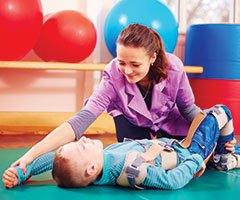Respiratory Syncytial Virus (RSV)
Understanding RSV in Children
Respiratory syncytial virus (RSV) is a common respiratory virus that affects individuals of all ages, but can lead to sever complications in infants and young children. We understand the importance of recognizing the signs and risks related to RSV. Learn more about how to protect your child and reduce their risk of RSV infection.
-
Asthma/COPD Management - Golisano Children's Health Center
-
The Children's Rehabilitation Center - Golisano Children's Health Center
RSV Symptoms and Risks
Respiratory syncytial virus (RSV) affects the respiratory system and can range from mild cold-like symptoms to more serious respiratory issues. It spreads easily through droplets from coughs or sneezes and by touching contaminated surfaces.
Common RSV symptoms include runny nose, coughing, sneezing, fever, sore throat, and wheezing. Infants and young children may experience more severe symptoms, such as difficulty breathing or a loss of appetite.
-
Neonatal Intensive Care Unit (NICU) - Golisano Children's Hospital of Southwest Florida
9981 S HealthPark Dr Fort Myers, FL 33908
-
Pediatric Intensive Care Unit (PICU) - Golisano Children's Hospital of Southwest Florida
RSV in Infants & Young Children
Some people are more at risk for RSV than others such as premature infants, young children and those with chronic lung or heart conditions. RSV is a serious concern for infants and young children, so understanding how RSV affects infants, and knowing prevention and treatment options is an important part of protecting your child's respiratory health.
RSV primarily affects the lungs and airways in infants, leading to symptoms like coughing, wheezing, and trouble breathing. In some cases, RSV can lead to more serious conditions like bronchiolitis or pneumonia, which may require a hospital stay.
Common signs of RSV in babies include:
- Runny nose
- Sneezing
- Fever
- Loss of appetite
- Fussiness
More severe symptoms might involve:
- Fast breathing
- Chest pulling in with each breath (retractions)
- A bluish tint to the lips or nails, indicating a lack of oxygen
If you notice any of these serious symptoms, seek medical care for your child immediately.
Reducing Your Child's Risk of RSV
Protect your child from RSV by reducing their infection risk and the spread of RSV:
- Practice good hygiene: Wash your hands frequently with soap and water for at least 20 seconds.
- Keep a clean environment: Regularly clean and disinfect high contact surfaces such as doorknobs, toys, electronics and other items to reduce the risk of transmission.
- Avoid close contact with sick individuals: By avoiding close contact with anybody showing cold-like symptoms you can reduce your child's risk of exposure.



